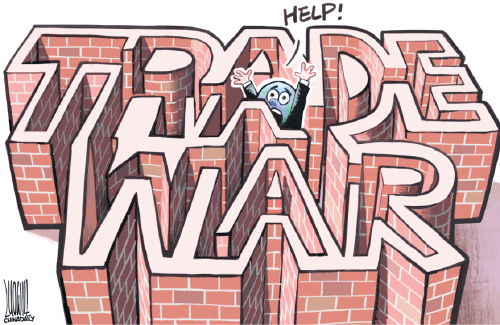Rethinking the US-China trade conflict

Opportunity to stop political miscalculation from turning into an economic disaster or worse
If, as seems certain, Joe Biden enters the White House, his administration will not have a clean slate when it enters office on Jan 20, 2021. That's especially the case when it comes to addressing the four-year conflict with China. What started out as a trade war, quickly morphed into a tech war that is now on the cusp of a full-blown Cold War. It will not be easy for either side to stand down from this increasingly contentious dispute.
Yet that is exactly what now needs to happen in order to prevent a political miscalculation from turning into an economic disaster, or worse. The US trade war with China was a serious mistake from the start. It may have been politically expedient to blame China for all that ails a deeply wounded US middle class. But this is where the political calculus gets fact checked by economics.
Most economists, myself included, agree that bilateral trade deficits are next to meaningless in a supply-chain connected world afflicted with large saving imbalances. The United States has the largest trade deficit in the world because it also happens to have the largest shortfall of domestic saving in the world. The US net domestic saving rate fell back into negative territory in the second quarter of 2020-at-1.2 percent of national income. At the same time, the overall merchandise trade deficit of the US hit a new record of-$970 billion (annualized) in the third quarter of this year.
This was hardly a coincidence. Lacking in domestic savings and wanting to grow, the US must import surplus saving from abroad and run massive balance-of-payments and foreign trade deficits to attract foreign capital. This gives rise to a multilateral trade deficit-a trade deficit with many countries. In 2019, the US ran merchandise trade deficits with 102 countries. That is where China fits into the equation-as one bilateral piece of an outsized multilateral US trade imbalance.
Yes, China accounts for the largest portion of the overall US trade gap. But that is a function of China's comparative advantage as a lost-cost producer of goods that fit US needs. It is also a function of the key role that China plays in global supply chains as an assembler of products such as iPhones that consist of components and parts made by countries all over the world. Because US trade statistics assign full value to exports based on their port of embarkation, China's role as one cog in global value chains seriously overstates its bilateral deficit with the US by as much as 40 percent.
This is where the current US administration's trade war has gone from dumb to absurd. By going after China for political reasons, the so-called bilateral fix has only exacerbated the multilateral problem. Indeed, without addressing the domestic saving shortfall-which currently is going from bad to worse due to a pandemic-related blowout of the federal budget deficit-the Chinese piece of the US multilateral trade deficit has been diverted somewhere else. That "somewhere" is undoubtedly a higher-cost foreign producer, the result of which is the functional equivalent of a tax hike on US consumers.
Facts bear that out. In 2019, the US-China merchandise trade deficit narrowed to $345.2 billion, an improvement of $73.8 billion from 2018. That was obviously a result of the trade war. Yet it did literally nothing for hard-pressed US workers. Excluding China, the merchandise trade deficit actually widened by $52 billion in 2019, with Mexico, Vietnam, Canada, Switzerland and Ireland filling most of the void. That means the narrowing of the bilateral deficit with China was largely offset by trade diversion to higher cost foreign producers. The attempted bilateral fix for the US' multilateral problem backfired.
The good news is that a Biden administration would understand simple trade math. That means there is a good chance that it will abandon the ill-fated Phase One framework, which was falling far short of its negotiated trajectory in any case. For the same reason, a rollback of punitive tariffs should also follow. That will allow a new team of US trade negotiators to turn its attention to the big structural issues that matter most-innovation policy, intellectual property rights, forced technology transfer, cybersecurity and non-World Trade Organization compliant subsidies to China's State-owned enterprises.
To its credit, the Trump administration underscored these structural issues in its March 2018 Section 301 report on China's alleged unfair trading practices. Unfortunately, the charges were based on very weak evidence. But that does not take these issues off the table. The challenge for a Biden administration will be to come up with a new framework of engagement with China that focuses on the structural challenges that both nations believe will be decisive in shaping their futures. The trade war diverted attention from what truly matters most. With cooler heads and a clearer focus, a cease-fire in the trade war should provide an opportunity for both nations to tackle the most important issues that divide them.

The author is a member of the faculty at Yale University and former chairman of Morgan Stanley Asia. He is also the author of Unbalanced: The Codependency of America and China. The author contributed this article to China Watch, a think tank powered by China Daily.





















